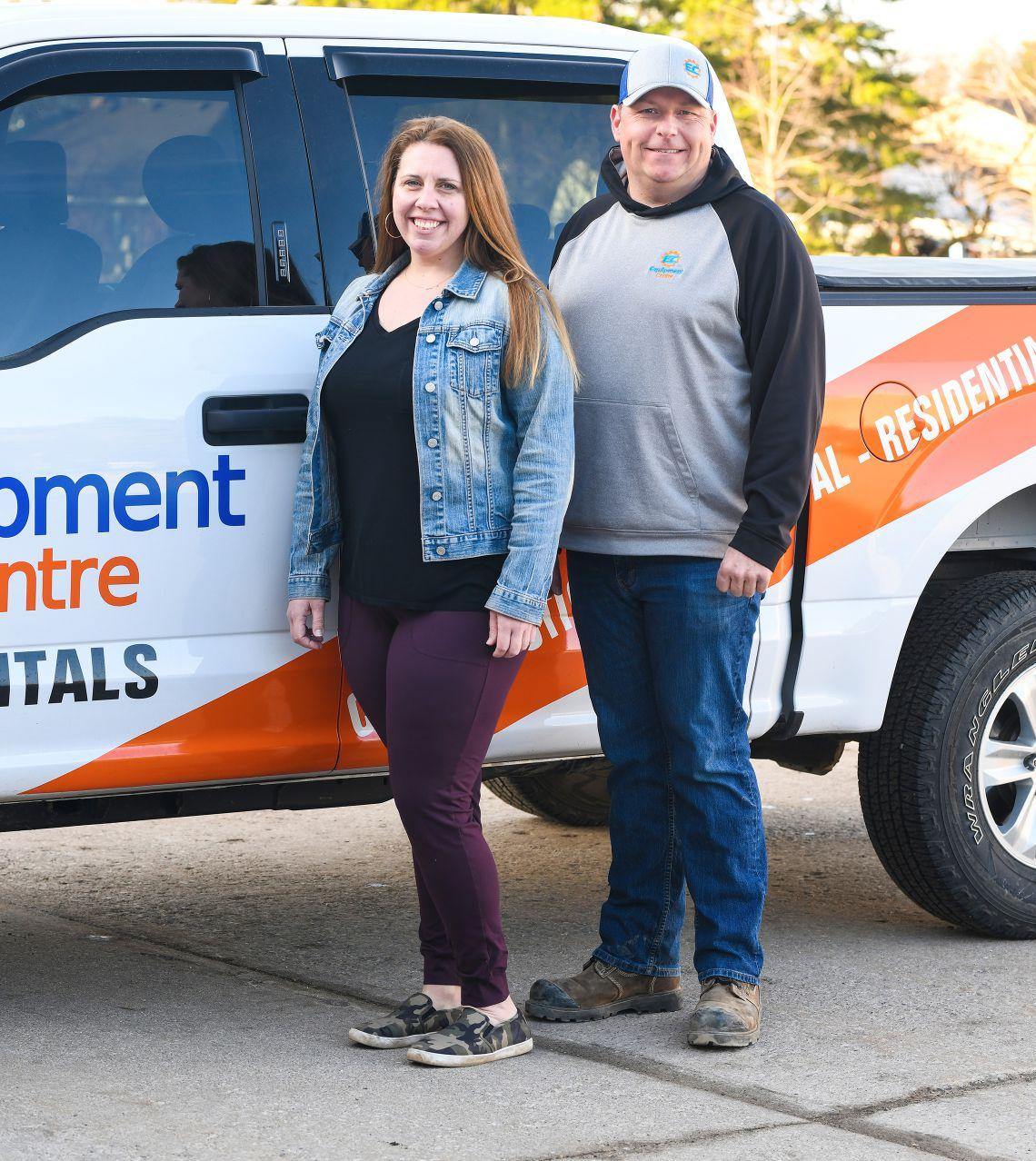




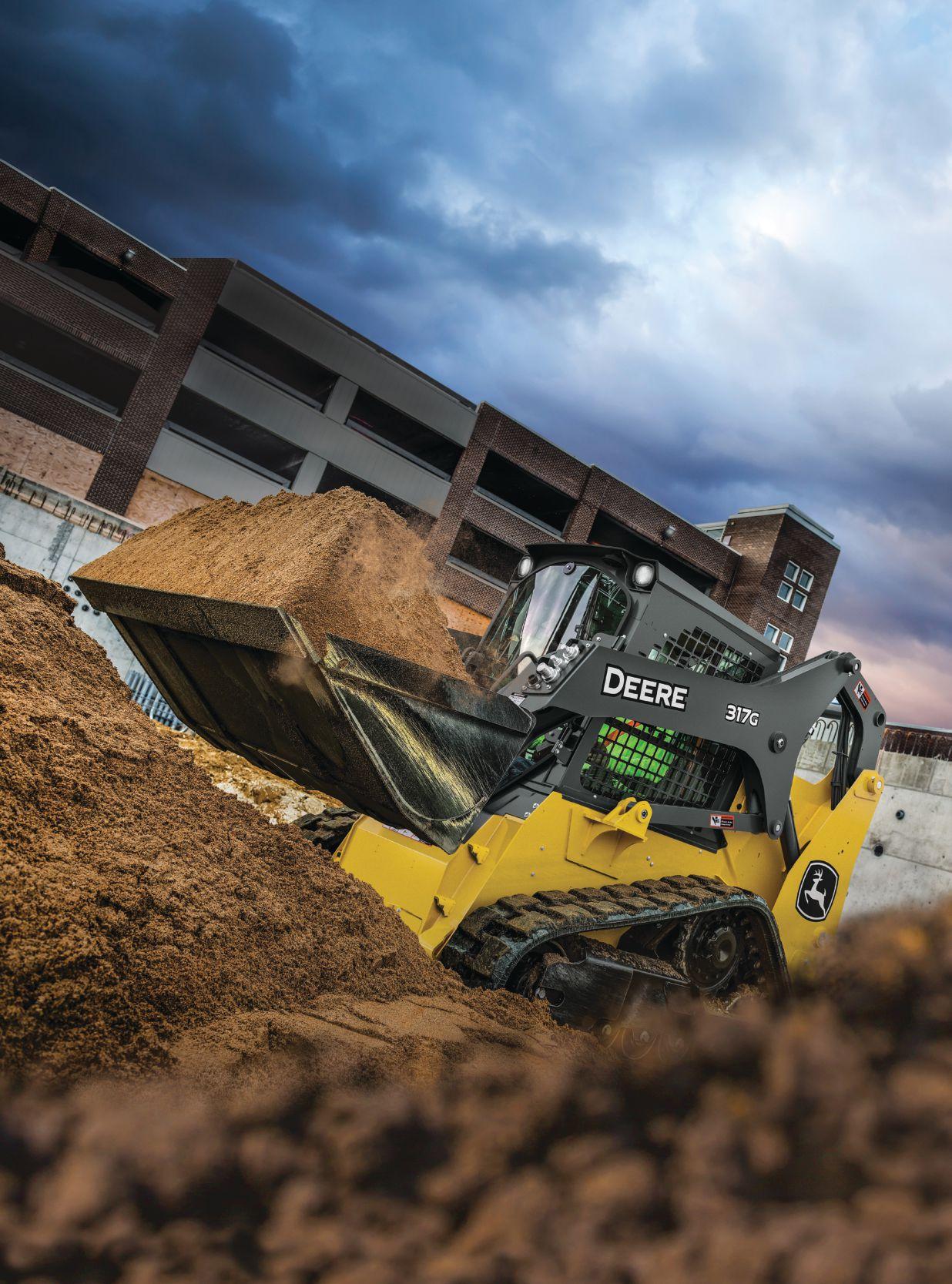
Being built for rental performance means these machines tackle the toughest jobs…again and again and again. The difference is clear. The difference is DEERE.
JohnDeere.ca/rentalsales

Annex Business Media
P.O. Box 530, Simcoe, Ontario N3Y 4N5
(800) 265-2827 or (519) 429-3966
Fax: (519) 429-3094
READER SERVICE
Print and digital subscription inquires or changes, please contact Shawn Arul, Audience Development Manager
Tel: (416) 510-5181 Fax: (416) 510-6875
Email: sarul@annexbusinessmedia.com
Mail: 111 Gordon Baker Rd., Suite 400, Toronto, ON M2H 3R1
EDITOR I Patrick Flannery pflannery@annexbusinessmedia.com (226) 931-0545
ASSOCIATE EDITOR I Sukanya Ray Ghosh srayghosh@annexbusinessmedia.com (647) 203-7031
PUBLISHER I Danielle Labrie dlabrie@annexbusinessmedia.com (226) 931-0375, (888) 599-2228, ext 245
ACCOUNT COORDINATOR I Barb Comer bcomer@annexbusinessmedia.com (519) 429-5171, (888) 599-2228, ext 210
MEDIA DESIGNER I Alison Keba
GROUP PUBLISHER/VP SALES Martin McAnulty mmcanulty@annexbusinessmeda.com
COO I Scott Jamieson sjamieson@annexbusinessmeda.com
Publication Mail Agreement #40065710.
Printed in Canada ISSN 0383-7920
Subscription Rates
Canada- 1 Year $45.00 + tax
U.S.A. - 1 Year $102.50 (CDN)
Occasionally, Canadian Rental Service will mail information on behalf of industry-related groups whose products and services we believe may be of interest to you. If you prefer not to receive this information, please contact our circulation department in any of the four ways listed above.
Annex Privacy Officer Privacy@annexbusinessmedia.com Tel: 800-668-2374
All rights reserved. Editorial material is copyrighted. Permission to reprint may be granted on request.
Serving the Canadian rental industry for 44 years.



4
Did the pandemic response make sense overall?
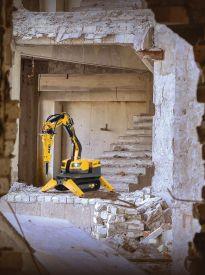
6
CooperConnect launched… Rental Mart report… Multinationals report positive results… The Utility Expo 2021 announced…

12 REVAMPED AND READY
Equipment Centre 2.0 is building on established success and creating new avenues for growth.
18
The rental industry has adapted quickly to the pandemic to ensure a secure future.
Latest advancements in PPE technology will keep your customers safe. By James Wong
AT YOUR SERVICE
Stop blaming COVID-19 and start offering solutions to your customers. By Russ
Dantu
Upselling is an art that can be used effectively to bring in the extra buck.
By Michelle Nicol
26 CONCRETE SHOWCASE
Warmer weather means concrete. Here’s what your customers will need.
30
HOPE IS NOT A PLAN
Recognize your limitations and hire the best people for your business. By Adam
Snook


A year on, we can assess whether the pandemic response made sense.
There’s a seemingly well-researched and fair article in the National Post this morning by Tom Blackwell looking at studies from around the world assessing the efficacy of lockdowns in fighting COVID (“They kill jobs, overwhelm treasuries, harm mental health but COVID lockdowns work, science suggests,” March 22, if you want to look it up). It lands, at the time of this writing, just about a year after the first declarations of global pandemic and emergency measures by governments. Over that year, I’ve watched as the currents of opinion on our reaction have split into those who feel the response has been a sad necessity and those who feel it’s been a wrongheaded waste of effort with devastating consequences that far outstrip the benefits (with individuals at all points in between, of course). I’ve certainly participated in lively debates with some who view the governments’ approach as a blend of incompetence and anti-business bias. In their telling, we would have done just as well to give special protection to long-term care homes and hospitals and let everyone else go about their business.
The article throws some cold water on this. The preponderance of the research done since the start of the pandemic indicates that lockdowns that close businesses, prohibit gatherings and generally prevent people from moving
CounterTalks episode #19: In the event of pandemic
One of the most frustrating things for any business owner is to face circumstances that hurt your business that you can do little or nothing about. The pandemic has certainly been this for Canada’s party and event rental industry. Eureka! is doing its part to help with two new guides that suggest ways event rental stores can find at least some replacement revenue, both from old sources and new. Tim Cronk joins CounterTalks to expand on some of the excellent points in these guides and talk about the innovative approaches he’s seen in the party sector.
Download episodes of CounterTalks at canadianrentalservice.com >Podcasts or subscribe on your favourite podcasting service.
by Patrick Flannery

around have been the most effective method for preventing spread of the virus and sharp rises in cases. There’s correlation between places that imposed lockdowns late, unevenly, temporarily or not at all and bad results in terms of infection rates and deaths. In one place the article points out that, had we taken Florida’s approach, we would have seen an additional 33,000 deaths in this country. For reference, Canada has as of today around 22,000 COVID deaths total.
Caveats abound. What is a lockdown? Even inside Canada we’ve seen diversity in the specific rules. Places that locked down early with strong testing and tracing regimes (South Korea, Australia) were able to return to very light lockdown measures quickly without a return of mass infection. Was it the lockdowns or was it the masks? The early confusion around mask-wearing may have had a devastating effect. A few of the studies found weak or no evidence that lockdowns helped. And one lockdown critic from Alberta estimated the collateral damage in terms of lost “wellbeing years” to be five to 10 times greater than the overall health benefits of stopping the pandemic. That seems hard to agree with, but it’s worth asking ourselves if all this was worth it.

My answer comes from a thought experiment. If you were living in a small village in, say, India, and a man-eating tiger was killing your neighbours, would you shoot it? Or, out of concern for preserving an endangered species and preventing an ecosystem collapse that would imperil the long-term future of the village, would you refrain? I think the common-sense answer to that question is to deal with the present threat, understanding that a lot can happen over time and there will be opportunities to deal with the fallout later.
The fallout, in the case of the pandemic, has in many cases been severe damage or even destruction of our businesses. We’ve met, with middling success, what I consider to be a moral duty to save as many lives as we can. But now our thoughts must turn to what will be done to repair the damage to so many lives and livelihoods. CRS

The Ontario Construction Secretariat hosted its online State of the Industry and Outlook Conference on March 4. Many presenters commented on the fact that the last time the conference was held in 2020 also marked the last live event they had attended since. As always, the OCS presented a very informative and comprehensive overview of the Ontario construction environment. The event featured an economic update from CIBC deputy chief economist, Benjamin Tal, OCS director of research Katherine Jacobs’ report on her survey of contractor attitudes, a panel discussion on health and safety on jobsites and a presentation and question-andanswer session with senior editor of The Atlantic, David Frum. Tal’s presentation outlined a recession that was unlike any ever seen before in history. He described the road forward as one of “normalizing the abnormal.” Both Tal and Frum noted that American trade policy was unlikely to change much under the Biden administration. He said it was urgent for Canada to obtain carve-outs from Buy America policies that would maintain our access to U.S. government procurement, especially given the really incredible amounts ($400-500 billion) they are looking at spending on infrastructure. Part of the very strong, fast recovery Tal predicts will be a surge in demand for labour and Canadian companies, with their reliance on immigration for recruitment, could find it hard to obtain talent. Tal sees increased regulation of the U.S. energy sector being a boon to Canadian energy producers, despite the cancellation of the Keystone pipeline. Canada lost jobs in January while the U.S. gained slightly, but Tal acknowledged this was a tradeoff between better economic performance and higher rates of infection. On the overall effects of the pandemic, Tal is relatively upbeat. He described the recession as deep, but very narrow. It has been unlike any other recession in that service industries have been hit far worse than goods providers. Broadly, the economic effects of the pandemic bit into the economy worst a year ago in March and April of 2020, then quickly recovered as people got used to working in and around the restrictions. Tal mentioned that the pandemic may have spurred the long-awaited productivity improvements in Canadian manufacturing and construction as companies
were forced to take risks. Tal’s numbers showed one to two percent growth for the Canadian economy over the winter. He predicted a stronger recovery in the second half than the Bank of Canada’s forecast. Tal pointed to the disproportionate impact on the service sector, which has more flexibility to bounce back faster than manufacturing. Canadian incomes actually rose during the pandemic, which has never happened in a recession before. Jobs losses were restricted to low-income earners – higher paying jobs gained 350,000 positions last year. Yet the spending decline was all at the upper income levels. The net effect, Tal said, is Canadian households sitting on $90 billion of excess cash, representing a big well of pent-up demand. He predicts five to six percent GDP growth in Canada in the second half of 2021. Another fascinating prediction from Tal was that the pandemic has created the conditions for a permanent increase in government spending. Public spending in Canada was around 15 percent before the pandemic and has now jumped up to 35 percent. Tal thinks spending may drop back to around 17 percent and stabilize there. He feels the forced experimentation with pandemic programs has opened the door for further innovations in government policy. Tal acknowledged that conditions now look like the classic conditions for severe inflation, especially if governments overstimulate the economy with continued spending once the pandemic is over. But inflation has stubbornly resisted other apparently inflationary circumstances for many years and with interest rates continuing to be held low Tal was unsure if it would get going this time. “One thing economists have found out since the ’70s,” Tal said, “is that if inflation is hard to stop, it’s also hard to start.” Tal called this the “most housing-friendly recession in history.” Tal pointed to the assymetrical nature of this recession, with the brunt of the impact falling on lowincome workers who were renters anyway and higher-income people often being better off. The housing market has acted the opposite of how it normally does in a recession in other ways, too, with demand exceeding supply and price inflation going faster outside big urban areas than inside them. Tal noted a decline in downtown condo prices, but said the damage was all in the resale market . He views the work-from-home phenomenon as not likely to put a long-term dent in demand for office space.
Cooper Equipment Rentals has launched an online customer portal with a wide range of account management services for its customers. The Mississauga, Ont.,-based rental chain calls the service CooperConnect. Accessible via the cooperequipment.ca website, it offers:
• Updating purchase orders on active contracts
• Executing the rate calendar on any asset on rent, listing the most economical time slots to call something off rent

• Extension of return dates and setting alerts for when equipment is due back
• Setting dates and times for picking up equipment or calling off pickups
• Data export to Excel
• Setting automatic email reports
• Viewing invoices and account status
The service includes the ability to customize views to show the information most important to the customer. Equipment on rent is listed and linked to its onboard GPS tracking so customers can view its location and usage meter from their desktop.
Herc Holdings recently reported its 2020 fourth quarter and full-year 2020 results. It also announced full-year guidance for 2021. According to the report, equipment rental revenue was $427.3 million in the fourth quarter and $1,543.7 million for the full year. Total revenues were $520.4 million in the fourth quarter and $1,781.3 million for the full year. Net income was $35.5 million, or $1.19 per diluted share in the fourth quarter, and $73.7 million, or $2.51 for the full year. Adjusted earnings before interest, taxes, depreciation and amortization was $195.6 million in the fourth quarter and $689.4 million for the full year. Free cash flow increased to $424.5 million for the full year. The company announced full-year 2021 guidance ranges of $730 million to $760 million for adjusted EBITDA and $400 million to $450 million for net rental equipment capital expenditures.
““We exceeded our expectations for the fourth quarter and have good momentum going into 2021,” said Larry Silber, president and CEO. “During the year, we adjusted fleet to respond to the declines in volume related to the impact of COVID-19 on our customers and focused on controlling costs. The quick implementation of those initiatives led to our improved adjusted EBITDA margin and excellent free cash flow for the full year. Our
commitment to customer service and consistent implementation of a strategy to diversify our customer and industry base continues to demonstrate the strength of our business model.”
United Rentals announced its financial results for the fourth quarter of 2020 and provided its outlook for 2021. According to the reports from the fourth quarter, total revenue was at $2.279 billion, including rental revenue of $1.854 billion. Fleet productivity decreased by 3.8 percent year-over-year, mainly due to lower rental volumes. Fleet productivity improved 420 basis points sequentially, primarily due to better fleet absorption. Net income was $297 million, implying a net income margin of 13 percent. GAAP diluted earnings per share was $4.09, and adjusted EPS was $5.04. Adjusted EBITDA was $1.037 billion, implying an adjusted EBITDA margin of 45.5 percent. Full-year net cash from operating activities was $2.658 billion; free cash flows was $2.440 billion, including gross rental capital spending of $961 million. Year-end net leverage ratio was 2.4 times, with total liquidity of $3.073 billion.
Matthew Flannery, CEO of United Rentals, said, “I want to thank our employees for safely supporting our customers in 2020 and delivering an exceptional performance despite unprecedented challenges. Results
for the fourth quarter exceeded our expectations, driven by stronger rental volume and robust used equipment sales. We are encouraged by the momentum this gives us going into 2021.”
Ashtead Group published unaudited results for the nine months and third quarter ended Jan. 31. Highlights from the results include: strong market outperformance; revenue was down by two percent of which rental revenue was down by three percent; operating profit was $1.192 billion; pre-tax profit was $1.044 billion; earnings per share was $174.15; and net debt-to-EBITDA leverage was 1.6 times.
Ashtead’s CEO, Brendan Horgan, commented, “We have delivered another strong quarter of market outperformance across the business contributing to rental revenue down only three percent in the nine months at constant exchange rates. I am extraordinarily proud of, and grateful to, all our dedicated team members who have made this possible, delivering for all our stakeholders, all while keeping our leading value of safety at the forefront of what we do. This performance illustrates the successful execution of our long-term strategy, which we embarked upon after the last recession, to broaden and diversify our end markets and strengthen our balance sheet.”
The Association of Equipment Manufacturers has announced that The Utility Expo – formerly known as ICUEE – is on pace to be the biggest one yet. With a new outdoor layout featuring more space for overhead and underground utility equipment, there’s a lot for exhibitors and attendees to look forward to when the expo opens in Louisville Kty., on Sept. 29. Registration for The Utility Expo opens May 11 and is scheduled for Sept. 28 to 30. Nearly 1.3 million square feet of exhibit space has already sold. Also, a recent survey of past ICUEE attendees found 81 percent plan to send the same number or more individuals from their organization; 91 percent indicated they are likely to make purchase decisions at the show; and 98 percent say they are excited about the show. The demolition of Old Cardinal Stadium from the Kentucky Exposition Center grounds allows The Utility Expo to use that newly paved lot for exhibits, serving as a massive contiguous exhibit area connecting the indoor exhibits in North Hall and the traditional digging space in Lot K. The new layout also provides for the opportunity to group similar product types, making it easier to navigate and find the equipment at the show. Moving the exhibits to the north side of the hall greatly simplifies parking and traffic flow. Whether those attending this year’s show drive, use ride share, or take the hotel shuttles, they will have a quick and easy experience in getting in and out of the show grounds this year. The health and safety of all show participants is a top priority of The Utility Expo, and show leadership is taking proactive steps to follow policies and guidelines of the Centers for Disease Control and Prevention and the Kentucky Exposition Center to ensure a safe and rewarding in-person experience for attendees and exhibitors alike. The Kentucky Exposition Center has GBAC Star Facility Accreditation, which means the expo center has the gold standard when it comes to cleaning protocols and work practices to combat infectious diseases like COVID-19.
Canadian Rental Service hosted the first virtual edition of Canadian Rental Mart on March 24 and it was a great success. Pat Flannery kicked off the day by welcoming all particpants. The first session of the day, the “Cross Canada Rental Panel” was a lively discussion that kept the audience hooked to their computer screens. The conversation of course began with what the panellists were seeing in their businesses and how everyone was coping with the impact of the pandemic. Panellists Blake Menning, Jeff Campbell and Paul Van Staveren all agreed that their businesses had to pivot to certain degrees to keep them going forward. Menning noted that his business focussed on building relationships with vendors and suppliers. His shop has a mandate that even if they get a call on at early hours of the morning, someone is out on the road within 60 minutes and the rental is given for free if that does not happen. The panellists also talked about rates. Campbell explained that, in business, you can pick any two components out of quality, service and price. His business chose quality and service. He added that there are people who are willing to pay for quality and service and that is the least expensive way of doing business. Van Staveren commented that the problematic part is the increasing equipment costs that need to be factored into the pricing. On supply chain issues, Menning noted that there were backlogs with getting equipment in. Representing the event and party rental industry, Mike Wood also joined the panel discussion. Talking about the impact of the pandemic on this segment of the rental business, he said that in March 2020 all revenue for the remaining year for his business evaporated within three days. The company had to lay off all its employees at a certain period. The company lost 97 percent of its gross revenue in 2020, which was about three million dollars. It was a struggle for the party and event rental segment overall. Chiming in on the rates discussion, Wood noted that all competitors should ideally come together and decide the rates that are acceptable for all to survive. However, he acknowledged that it is difficult when competitors decide to lower rates to gain business. The discussion also touched on online business and how much the rental industry would function physically versus online. Menning discussed that it was important to be cognizant of what the customers were looking for, many of whom were interested in digital tracking and data. Campbell noted that in-person interactions would be able to offer personality and problem-solving options. However, he added that staying out of the loop would also not be good in this day and age. Wood noted it is wise to have a combination of in-person and virtual services to benefit the most. The second live session of the day was the keynote address from Skyjack president Ken McDougall. McDougall presented an overview of the rental industry, talking about the rental revenues, forecast for the coming years and trends

that Skyjack noted. He also talked about the company’s “We Rise” campaign that was launched to highlight the reports of community spirit that the company saw across the globe. McDougall noted that the two key factors that help to steer the industry forward are supply chains and consolidation. He noted that it was important to build relationships with supply partners. McDougall noted that to reduce total cost of ownership for Skyjack products, the company focussed on using significantly less emission regulation components. That means no diesel oxidation catalyst to reduce maintenance; no downtime related to after-treatment issues in colder climates and no reliance on ultra low sulfur fuel, all of which improves the resale options. He noted that consolidation of smaller rental companies affected the revenues of the rental businesses. McDougall also discussed the new products that the company has recently launched. Besides the two live sessions, a recorded session featuring a conversation between Mike Wood and Pat Flannery was also hosted on the Rental Mart platform. This discussion focussed primarily on the event and party rental segment. Wood shared how he became a part of this industry with Ottawa Special Events. He then went on to discuss how the pandemic impacted his business and set him on a path to have discussions with key government people on the situation of all people in this segment. Wood noted that small businesses were the most hard-hit by lockdowns and it was difficult for them to obtain of the benefits of the different government programs that were in place to help. He added that banks acting as adjudicators were trying to help small businesses access the programs. Wood noted that movie companies filming in Ottawa helped his business during the pandemic shutdowns. Wood advised that event rental companies should call their public health departments and try to find out what is happening with the vaccination centres. They could make phone calls saying they have tables, chairs, pipe-anddrape, and several other items that could aid in setting up vaccination centres. Besides the sessions, the audience was able to take advantage of networking breaks to connect with different stakeholders in the industry. The cherry on the top is that all registrants can conitnue to access all the sessions on the event platform any time they want. CRS
EquipmentWatch is a trusted source for heavy equipment data and intelligence, producing leading database information products for the construction equipment industry. It is a world leader in heavy construction research and serves more than 15,000 professional, high-volume users of construction and lift-truck data. Find more heavy equipment intelligence at equipmentwatch.com.
A look at average national rental rates
The Cross-Canada Rate Report is provided to Canadian Rental Service as a free service to the Canadian rental industry. Rate data shown are national averages generated by quarterly surveys of 458 Canadian rental stores. Rates shown are reported list rates and may not reflect the actual changes to any particular customer. For in-depth analysis, subscribe to CounterTalks at canadianrentalservice.com or through your favourite podcasting service.
Number of rental companies:
54

Number of stores:
458
Number of rates collected in Q4 for 2020
89,130
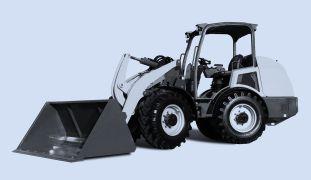


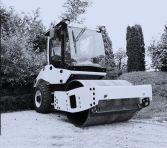
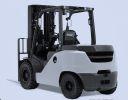
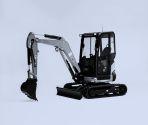
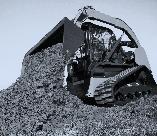
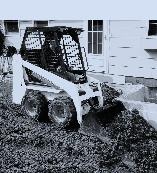
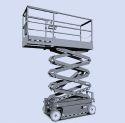
by Russ Dantu
I’ve had a few fender benders in my time. Every one of them has been someone else’s fault and non-injury affairs, luckily. Unfortunately, it is irritating because it is an inconvenience to have to phone the insurance company, have someone look at the damages, arrange for a rental car, and cross your fingers, toes, legs and eyes that it gets fixed quickly and properly at the auto body shop.
At best, my previous experiences have been taken care of with average service at best. Being a customer service specialist, I am always analyzing service that is given to me.
Such was the case with my latest mishap. A co-worker was backing out of our showroom parking lot and scraped the bumper of her pickup truck against the front quarter panel of my truck. She thought she was clear but left quite the amount of scratches and dents, even though she wasn’t even travelling five miles per hour.
She immediately came back in to let me know. She’s never been in an accident before. I smiled and said, “Shit happens. No one got hurt. It’s all good. We’ll get the insurance to handle it!”
I have a fabulous insurance company I deal with and she gave me the number for Intact and gave me some pointers to help the process. I’ve had good luck with Intact over the years and they were quick to help out this time. I chose Horton Auto Body because it is fairly close to my home, they are on Intacct’s preferred list, and they work with Enterprise Car Rentals (they pick you up) so obtaining a rental would be easy.
Fifteen minutes after my call to an Intact rep, I received a call from Horton Auto Body to set up a time to do an appraisal. I then received a call five minutes after that from Enterprise because Horton Auto Body had said they would get them to call. I set a time for the next day, went there and Brendon had the appraisal done within 15 minutes (over $2,500 for the small incident). He told me the time for this job said seven business days but said we can likely have it done in four.
I needed a few days to take care of some other projects before dropping the car off. I arrived at 8 a.m. on the day of drop off. Brent helped me again and Enterprise were waiting for me to take me five minutes away for my rental truck while

my Toyota 4Runner was being fixed.
Four days later (not five), the manager, Kevin, called me to say the repairs were done…ahead of schedule! I was able to leave my rental with them and they took care of having Enterprise back to pick it up. What was even nicer was that when I got in the car, it had been completely detailed, washed and waxed.
Later that day, I received a survey from Horton Auto Body. I don’t always take time to fill these in but was more than happy to and I gave them a raving review. I then phoned Kevin back to tell him how impressed I was with the whole process of working with them, from the front desk office manager, to Brendon to him! There wasn’t one thing I could have complained about or thought was average service. They made sure that every detail of this experience was pleasant and went above and beyond to have my vehicle back ahead of time.
I will say that timing is everything and it wasn’t a particularly busy time for them but from speaking to a few other people that know them, they always provide this type of service.
When we deliver exceptional customer service consistently, what happens is this: we develop a reputation for being a leader in our field. We get more word-of-mouth referrals from people who have dealt with us – they talk about how good we are. We make people happy because they don’t really expect exceptional customer service because it isn’t something you see every day. It leaves a lasting impression. I’m still raving about this and it’s been a month since I left their shop.
I’ve said it before but I’ll say it again,: customer service isn’t rocket science, but so many companies make it that way. It is the easiest way to differentiate your business from others in your field. If you want more customers and happier customers, start delivering exceptional customer service in every aspect of your business!
Take care of yourselves, your customers and your employees! CRS
Russ Dantu is a 30-year veteran of the rental industry and has been delivering workshops, seminars and keynotes on customer service for over 15 years. Visit russdantu.com.

TM EQUIPMENT REDEFINED TRADE FOCUSED SYSTEM WIDE












INDUSTRY’S FIRST CORDLESS EQUIPMENT SYSTEM
The newish owners of Equipment Centre
2.0
are capitalizing on the strengths of this established business.
When business partners Jeremy Graham and Sherri Graham decided to purchase a rental business in southern Ontario in 2017, they knew they’d make some big changes, but they certainly also wanted several central aspects of the business to stay essentially the same.
BY TREENA HEIN
Equipment Centre 2.0’s owners Jeremy Graham (in picture) and Sherri Graham have built on the established business while also making bold changes to take it even further.
The Equipment Centre was started by Jim Young in 1974. At one time, there were four locations but by the time Jim was ready to retire from the business in 2017 there were two, in Courtland, Ont., and Simcoe, Ont. Through a historical working relationship between Young and Sherri’s family, Sherri and Jeremy became aware of the chance to purchase the company – and they’ve never looked back.
“We were looking for the opportunity to own a business and we got our financing in order and went for it,” says Sherri. Neither
had owned a business before. Sherri had been in social work and Jeremy had been in the construction industry as a service technician and customer service rep. Their combined skill set, however, has provided a solid foundation for success. Their busy roster of customers ranges from large road and building construction companies and municipalities, to tradespeople, home builders, landscapers and homeowners doing their own renovations.
Right away in 2017, they added about $1 million in new construction industry

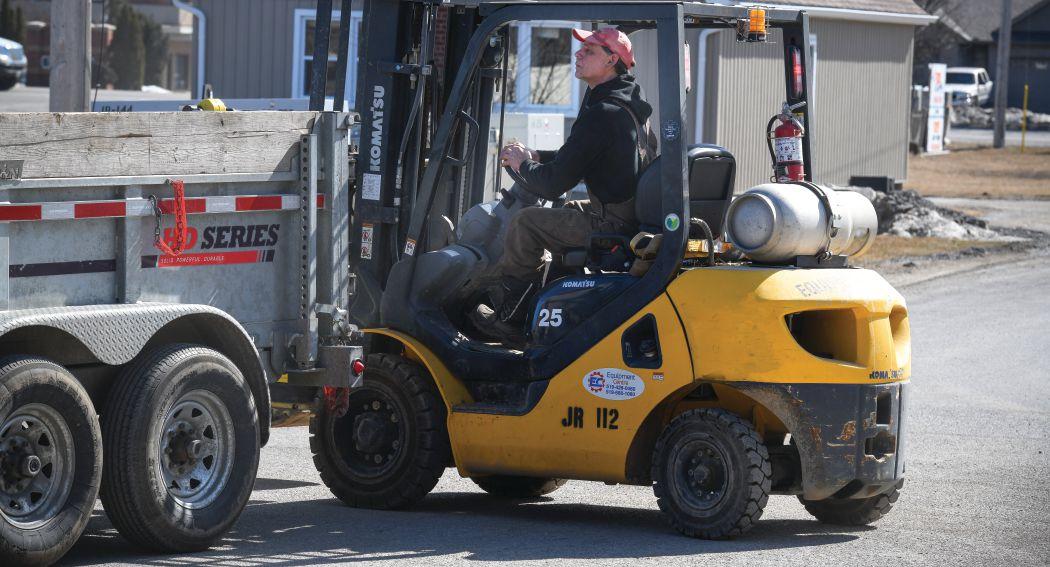
equipment to their lineup. And as they had hoped, the response from those customers was strong. It was a classic scenario of “if you build it, they will come.” Remembering that year, Jeremy says “we got into articulating booms, heavy excavators, telehandlers, heavy rollers and some specialty equipment for landscaping contractors like stump grinders and chippers. We also added a fleet of mini-excavators, some skid steers and more.” And already this year, Equipment Centre 2.0 has purchased two track loaders, a 5,000-pound telehandler and a line of concrete cutting tools, with plans for adding more mini-excavators.
“Customers love the new equipment,” Jeremy says. “The only challenge is that new units are really hard to get right now because COVID has really affected the supply chain. Some lift suppliers are 120 days out for delivering anything with a gas engine.” The cost of new equipment is covered by profits and proceeds from the sale of older equipment, which is also a hot commodity right now. “We’re making good margins on selling equipment, again due to a scarcity of new equipment due to COVID,” Sherri explains. “For new purchases, our customers really guide us in what we buy and what brands we look at, but staff input is also very important.”
Purchasing all the equipment they
have since 2017 has been a very successful business strategy. To reflect their new ownership and new era for the firm, Sherri and Jeremy added the
Adding to the equipment lineup has proved beneficial for Equipment Centre 2.0.

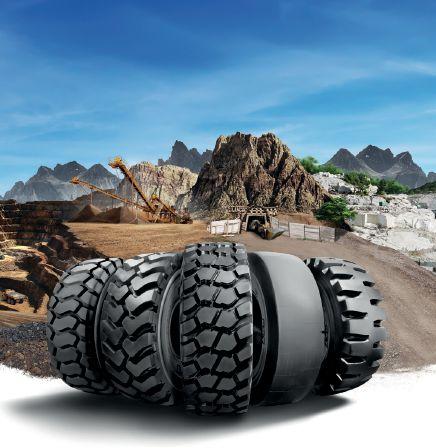
WHEREVER YOU ARE, BKT IS WITH YOU

WHEREVER YOU ARE, BKT IS WITH YOU
BKT
WHEREVER YOU ARE, BKT IS WITH YOU
BKT
BKT provides you tires that are sturdy and resistant, reliable and safe, able to combine comfort and high performance. BKT is with you, even when work gets tough.
2.0 to the name. But they also kept the main part of the name so that customers would know Sherri and Jeremy would continue to provide the great service that community businesses have known and loved for many years.
One of the central aspects that Sherri and Jeremy most appreciated about the business when they bought it was the trusted relationships that staff members had established with customers. They wanted to enhance that customer service level to even higher levels. To ensure that customers didn’t have to wait for equipment, they bought additional delivery trucks and hired two full-time drivers. They also made more staff available by phone so that customers could reach someone right away and get a quick response, especially after hours.
And while they’re not located in an area where big-chain competition is likely to move in, Sherri and Jeremy both believe excellent ongoing service and a bigger selection will prevent customers from having to go to outside the community to rent anything they need.
It also helps with customer trust that the entire team grew up in the area, and are therefore well known in the community (in fact, three of the employees at the Simcoe location are brothers). Jeremy adds that “We play as a team. I drive truck, I do anything and everything, and customers appreciate that too.”
The lynch pin for success at Equipment Centre 2.0 is of course the staff. “For me, one of the most exciting parts of the business was the staff and their strength and dedication,” says Sherri. “When we bought the business, the least amount of time anyone had worked here was ten years. Some had worked here over 20 years. They’ve been the ones who have built and maintained the relationships with our customers. We did our best to show them right away that we highly respect them and that their opinions matter. And we make sure to find out their
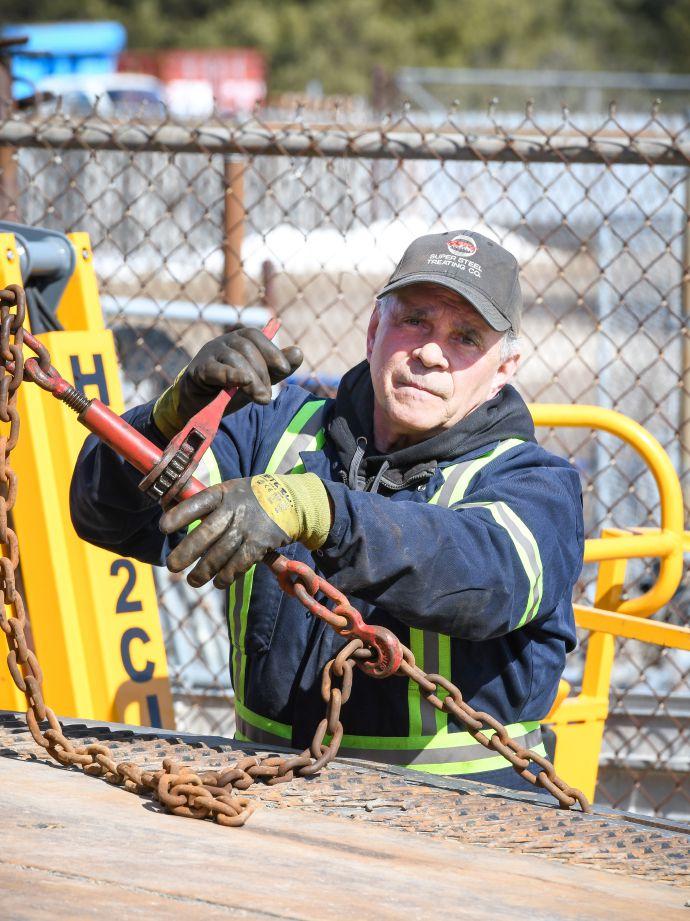
“To reflect their new ownership and new era for the rental business, Sherri and Jeremy added 2.0 to the shop’s name.”
needs and meet those needs. It’s been our number one job and we’ve been so fortunate.”
Every staff member is full-time year round, except there’s a summer student who will be returning again this
summer who also works some weekends throughout the year.
Equipment Centre 2.0’s office manager, Deb Guthrie, had worked at the business for 27 years before Sherri and Jeremy took over, and they consider

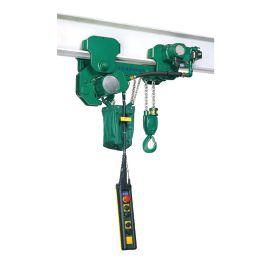






her to be an integral core of the business. Guthrie says “when we ask for something, it’s taken care of. I think Sherri and Jeremy have made positive changes and we’re all feeling confident. We’re busier than ever and we’ve increased our customer base. The customers are getting newer equipment and they’re happy.”
Big or small, every part makes a difference.


If you take availability of new equipment out of the equation, COVID has had a positive effect on Equipment Centre 2.0. Traffic has been steady from their building construction and road companies, among others, since just after the pandemic began. “During the first lockdown, the core staff worked from home and we started meeting customers outside,” Jeremy remembers. “But we haven’t slowed down since. Typically, the winter months are pretty slow for any rental business, but this year we haven’t seen that. With people staying at home, more homeowners have been coming through the door to rent tools for various home improvement projects. They’re doing additions and renovations instead of going on vacations.”
To keep things going in the right direction, Sherri and Jeremy have been working hard on social media to let people know what equipment they have available, the variety of projects in which contractors are using their equipment, and to show they care about the community. Sherri planned a fundraiser at Christmas time and got other businesses involved.
While Sherri and Jeremy might expand to a third location down the road, that will depend on how the construction industry fares in the short-term future. Other than that potential expansion some day, their goals remain what they have been since 2017 – to keep meeting the needs of their employees and their customers. After all, when the 2.0 version of the business is doing so well, there’s no need to create another. CRS

To celebrate International Women’s Day, eight of Canada’s leading construction media brands teamed up to deliver an exclusive virtual event. You can view the content ondemand, and stay on top of news throughout the year, at women-in-construction.ca.
PLATINUM SPONSOR

GOLD SPONSORS
SPONSORS

SPONSOR


by MICHAEL FREY, rental operations manager at Finning Canada
In the rental industry, COVID-19 has changed the way everyone does business. The pandemic has forced us to find innovative ways to keep workers safe and projects moving forward. It has also accelerated tech adoption and shines a light on the opportunity for companies to see technology as a way to increase efficiencies and transform business operations.
In addition to economic impacts and changes to how rental businesses operate on a day-to-day basis, COVID-19 has also introduced a host of other challenges. These include updating health and safety practices to protect customers and employees, communicating on a frequent basis, engaging in pandemic planning, and putting resources and measures in place to ensure safety regulations are met.
Here are some pointers on how to keep workers and customers safe while ensuring business continuity for your rental operation.
Almost overnight, the construction industry
changed. At the beginning of the pandemic, rental equipment was quickly being returned and there was anxiety and concern amongst customers and stakeholders. Little could be done without extensive health and safety protocols and the ability to go on a customer’s site was drastically limited. As business quickly changed, the rental industry had to adapt. Although many were able to move to remote working, at the field and service level it wasn’t that easy. Employees were still needed to assist customers. This required an investment to outfit branches with the tools and measures to operate safely, which included an audit of every single location. Every identifiable risk was considered. As COVID
When adapting to the pandemic, a major prerogative for all rental businesses continues to be providing a safe environment for customers and employees.

measures became the norm, there was an increased need to maximize project productivity, doubling down on not just health and safety, but scheduling and resourcing.
It is expected that pandemic protocols and procedures will continue into the near future. The number-one priority continues to be providing a safe environment for customers and employees. It’s about posting signage for safety protocols and ensuring employees are following new processes for cleaning and sanitizing equipment, including last-touch disinfecting. Plexiglass dividers were also installed between customers and staff where required, and personal protective equipment and designated rooms for quarantine were provided. Employee health pre-screening was also developed, ensuring our people remained home when experiencing any symptoms and followed the recommended public health guidelines before returning to work. Increasing digital capabilities also helps both the rental dealer and the customer – including utilizing electronic invoices, virtual meetings when possible, and ensuring customers can view equipment online and schedule rentals from their computer or mobile app.
For the rental industry, one of the biggest opportunities that has come from the pandemic is a greater awareness of the value of technology.
Technology has helped reduce the number of staff on site, ensuring social distancing and compliance with health and safety regulations. It has emerged as the solution to many issues for the rental business, ensuring information, processes, software systems and equipment are all working together to provide an in-depth view into what is happening on the jobsite.
There has also been an increased focus on the benefits of telematics and remote monitoring for rental equipment as it can provide even greater insights including quick, reliable, data-based technical troubleshooting, without putting anyone at risk. This also includes personalized maintenance reports, monitoring fuel efficiency, helping to track equipment, collecting data on operator behaviour
and supporting maintenance scheduling to reduce downtime. Remote monitoring will experience even broader adoption as we move into the future as it can help the rental business provide the right level of service through prioritization of critical repairs and the ability to review the assets’ overall health to determine scheduling of essential repairs and maintenance.
Almost every decision on- and off-site can now be made using a phone or tablet. Technologies like virtual training tools, videos and meetings are helping both rental dealers and customers get up to speed quickly, reducing on-site visits and the time needed for training. These technologies are reliable and have brought about significant changes to the industry. As internet connectivity improves, virtual training is expected to continue to be used even after lockdowns end. Advancements in virtual training can help better support customers meaning operators can experience exactly what they would if they were on a site, but from a safe and controlled environment. And as the workforce changes and a new generation of workers enter the industry, there will be an even better understanding and acceptance of technology.
The adoption of online business tools has been another positive change. Customers are researching equipment online more than ever and are using social media to initiate interactions with their dealership. LinkedIn, Instagram and Facebook have become important platforms in terms of connecting and working with customers, and we anticipate this will continue to be a part of the way business is done going forward.
Customer service is an essential part of every rental business, especially in-person interactions and relationships. When customers started to restrict non-essential access to their locations, it presented many challenges. It meant greater barriers to secure new business and gather information on site, to understand the customers’ needs and support them with



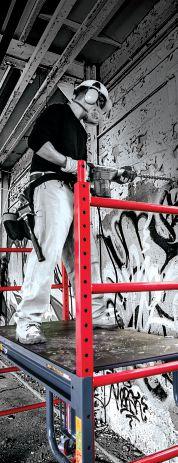






When you need to reach high places, the Snorkel S3220E delivers peak performance. Featuring a high lift capacity, this electric scissor lift offers a working height of up to 8.1m and a platform capacity of 409kg. Engineered to elevate jobsite efficiency, upsized pins provide additional rigidity for safe and secure performance. Its super-heavy-duty steel construction and over-engineered components maximize uptime and minimize ownership costs. That’s performance that stands above the rest.
FOR MORE INFORMATION, CONTACT AHERN CANADA ON 780-467-0600.

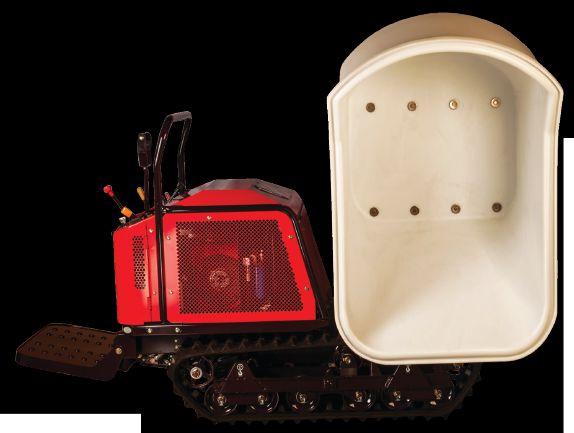

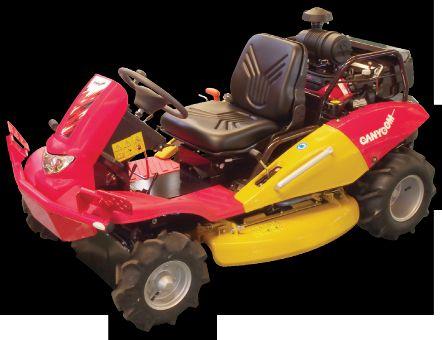
by James Wong
As the world streeks forward into the future of smart technology and the internet of things, so does the safety protection value of personal protective equipment. PPE innovations are most commonly seen in the form of wearables: sensors attached to existing PPE or newly designed built-in products. The end result collects and transmits data focussing on tracking, communication and warning alerts. These devices and systems enhance safety, increase work performance efficiency and provide on-demand scheduling. Here’s a list of technologies being developed and currently available.
Decibel level monitoring and speech identification Sensors send LED light signals detected by the user’s peripheral vision indicating impending noise hazards. The same sensor will send evacuation alerts and enable twoway communication with a smart phone app. Coupled with the general noise on jobsites, wearing hearing protection further diminishes the ability to communicate worker to worker. Noise blockers are now part of the ongoing improvements found in smart headsets and smart earplugs, blocking out noise and doubling as speech capable ear microphones.
Charge sensing boots There’s no limit to what these types of in-boot sensors will do. GPS sensors track the location of workers, monitor chemical and gas leaks and are also capable of sensing when a worker falls. The boot itself receives kinetic energy from walking, which powers the sensor system as well as charging for talk time on an iPhone. Even individual fatigue alerts can be programmed into these sensors.
Leather gloves New supercharged work gloves made from leather have eight times the protective value of standard leather work gloves. Shrinkproof with inherent softening longevity, the gloves use Kevlar stitching to increase the glove’s lifespan.
Tags Tags attached to PPE and mobile equipment detect and send alerts to the operator and crew, preventing accidents by using GPS coordinates. Alerts provide proximity warnings and each tag ID records the date, time and location of the alert, providing data for factors contributing to near struck-by and incidents as

they happen.
Real time learning Emergency evacuation confirmation and instruction alerts can be delivered in real time while monitoring the evacuation itself, tracking workers at muster stations and finding those who are still in the building. All of these advantages diminish evacuation time, impacting worker safety and possibly lives saved. Communication to first responders provide the location of people left inside and track life signs, heart rate, pulse and emotional state.
Just-in-time training The standard for safety training is training conducted prior to deployment. Taking this approach does not guarantee workers will have the ability to translate that training into action or habit. The use of technology to train on the job in real time has superior advantages by sensing work activities, worker safety, and potential hazards. By providing corrective actions and instructing occupational first aid treatments, the net effect is to maximize safety.
AI Now trained not only to detect and alert for hazards, AI can also analyse job types, detect missing PPE and provide social distancing alerts for group workers. Mitigating risks by using analytical data to compare and create benchmarks in real time is a jewel in the sand for the entire sector.
Adoption and training pose the most deterrent barriers for integrating smart technology. Latency issues are currently barriers for real time learning and just-in-time training because of the potential lag time. 5G infrastructure combined with Edge technology will eventually take care of any time inaccuracies to ensure there are no delays in communication. As with the history of all new technology, it’s expensive during the initial research and development phase presenting a disincentive for acquisition. Until it leans toward being widely used, we’ll just have to wait. Despite these challenges, smart safety’is a reality and before we know it, it will be everywhere.
Be safe. Be well. CRS
James Wong is an OHS chief for the construction industry.

by Michelle Nicol, CERP
When you think of upselling, if the image of a sleazy car salesman selling you something you don’t need comes to mind, you are not alone. There is a stigma attached to the art of upselling that can only be altered by offering our customers a transparent and fulfilling rental experience. It is time to shed the belief that upselling equates to taking advantage of someone and to not have their best interest in mind. Upselling is a win-win situation. Your client wins as they receive exceptional service and guidance in finding everything they need for their event. Your business wins as it increases the revenue of each sale so you not only hit your targets, but exceed them.
One of the most effective and efficient ways to increase your revenue is to look to your existing clientele. How can you make more money by adding on to existing and annual event rentals? What does that amount look like to you? Is it rounding up the plates, cutlery and glassware to the nearest dozen? Is it a recommendation to add on extra tables or chairs just in case unexpected guests show up? Do a little bit of reverse math to see what you would need to add on to each sale you did last year to hit your new goals and you will be amazed how manageable it can be when broken down.
Identifying upselling opportunities is something that takes time and requires practice in order to become a natural element of your conversations. Staff require training and the right tools in order to effectively upsell. Knowledge of products and how to operate them, available upgraded versions of items and inventory management are all components to successful upselling. Determine what they are actually looking for by asking deliberate and intentional questions. This will spark a conversation and build a relationship and also provide the detailed information required to guide them through their rental requirements. There are a few questions you can ask.
“Can you tell me a bit about your event?” Some people will share the logistical details such as date, time and location first. If you’re lucky, others will share more emotional information like what the event is, who will be coming and what their
theme is. This is your opportunity to connect with them, show interest in their event and offer suggestions on what rentals can add value.
“What is the most important aspect of the event to you?” This will provide insight into what they value most for the event, and what rentals can possibly support their vision. If the food is most important to them, suggest beautiful platters, stands and food display items that will accentuate the food and presentation. If the entertainment is most important to them, suggest adding an upgraded stage, backdrop and increasing their audiovisual rentals to properly showcase the talent.
The power of suggestion is a very strong skill. Your clients won’t know what they need until you tell them what you can offer them. “Wouldn’t this gold bubble charger plate look amazing under the plates you have selected?” “In my experience, guests are much more comfortable on this chair” (as opposed to this other, less expensive option). You want to be a storyteller, painting a vision for your clients to imagine and see it all come together with your suggestions.
When you have determined what base event rentals they need, make specific suggestions on items you would recommend. Instead of casually saying that they may want to consider renting a stage for the entertainment, ask questions about how many people are in the band, what kind of space they have for a stage and the look they are going for. From there, suggest a specific size, design of backdrop and details about the audiovisual kit. This not only shows you are listening to what they want, but you are a true professional who knows your inventory inside and out and can recommend the appropriate items. Be specific and intentional. You don’t have to try to upsell on every single item. When it comes to upselling, it’s quality over quantity; selecting the right upsells for your client will ensure they become a loyal customer and you make the highest return possible. CRS
Michelle is an award-winning account manager and festival specialist with Higgins Event Rentals in Toronto. She is an active member in industry associations and enjoys serving on a variety of boards and committees.
By KEITH ARMISHAW, business development manager for Aquajet’s North American subsidiary
However, not all hydrodemolition machines are created equal, and maximizing safety and efficiency means taking a look under the hood, so to speak. There are five key components that your customers need to consider when selecting a hydrodemolition robot.
Equal distance control Maintaining a close and constant working distance between the nozzle and concrete maximizes efficiency. With a standard system, operators can experience as much as 10 inches of variance as the water jet moves to the extreme left and right across the work surface. This variance leads to a loss of as much as 20 percent of the power before the water hits the concrete, greatly reducing productivity and increasing waste. Hydrodemolition robots with advanced systems are able to maintain a preset distance from the nozzle to the concrete surface, regardless of the attack angle of the water jet, allowing for precise, controlled concrete removal over the entire work surface. This saves energy and removes concrete more efficiently both above and below the rebar. Overall, this advanced system allows operators to effectively remove 20 percent more concrete per pump hour compared to standard systems.
Ceramic nozzles Inefficient nozzles waste time and increase operating costs. Steel might be stronger than ceramic in some situations, but not when it comes to nozzles for hydrodemolition applications. Depending on water quality, ceramic
Hydrodemolition offers contractors a number of benefits. From productivity to peace of mind, concrete demolition contractors have found great success with this robotic method.
nozzles from innovative manufacturers can last more than 350 hours, compared to less than 50 hours with standard steel nozzles. Using steel, a contractor would need to replace a single nozzle more than 10 times during the lifetime of one ceramic nozzle. And while steel nozzles are readily available at a lower cost than ceramic, more frequent changeouts mean contractors end up spending $300 to $1,000 on steel nozzles before replacing one ceramic nozzle. This results in thousands of dollars over the course of the hydrodemolition robot’s lifetime.
Computerized robotic management Control is necessary to be efficient, and efficiency leads to profitability.
Hydrodemolition robots with an advanced-but-intuitive robotic control system give operators futuristic levels of precision. Using cutting-edge technology, these systems allow operation at different depths in the same pass. A state-of-theart display panel uses clear and simple symbols combined with multi-language text, making it very easy to program the most advanced operations, including geometrical figures such as circles, triangles, squares and rhombuses.
Versatility Accessories are vital to maximizing a hydrodemolition robot’s value. Accessories increase the robot’s capabilities, helping contractors complete challenging projects in tough-to-reach areas or hazardous conditions. Look for hydrodemolition robots with a full suite
of attachments for maximum versatility. This can include extension kits and spines to extend the robot’s reach. Depending on an operation’s service offerings, though, it might also include rotolances for surface preparation or circular attachments for concreate removal around pillars and columns. Some manufacturers also offer kits especially designed for applications in pipes and tunnels.
Hassle-free transport Trailers add additional purchase and maintenance costs. Some manufacturers offer a unique solution with a self-contained high-pressure pump and engine system. Housed within a 20-foot container, these compact units provide ample space for transporting the robot and accessories, eliminating the need for a transport trailer altogether. On the jobsite these units can provide a secure work area, with amenities such as a built-in workbench with a vise that provide contractors a space for jobsite maintenance and a place to store spare parts. Advanced silentrunning units are also available that further decrease overall costs. These units can reduce idle time by as much as 50 percent, while operating as high as 3,000 bar.
Like any piece of equipment, the safety and productivity of hydrodemolition robots depends on available features. For maximum efficiency, look to partner with innovative manufacturers for the most advanced machines. CRS
by JEFF KEELING, North American sales and marketing manager for Brokk.
These innovative machines offer industryleading power-to-weight ratios with the versatility and efficiency to master a wide range of applications. But making sure a demolition robot is equipped with the right tool for the application can take operations to the next level. The wrong tool selection, on the other hand, can slow down productivity or leave behind unsatisfactory results. Here are some helpful tips for selecting the right tool to maximize breaking potential in a number of applications.
The moil point tool is the most common bit found on jobsites. The pencil-tip design focuses the entire force of the hammer and carrier in a 1/4-inch point, which limits vibrations, making it perfect for indoor applications and other situations where vibrations are unacceptable.
Good precision and control make it ideal for breaking hard concrete reinforced with rebar in applications such as walls, footings, floors, foundations or machine bases. However, it doesn’t provide the level of precision necessary for fine detail work.
The cone-shaped head can also get stuck. This is the result of the material failing to expand fast enough, which traps dust close to the tool and lodges it in place. Avoid this by paying special attention to the running time of the hammer. Don’t run for more than 20 seconds in the same spot without noticeable results.
The moil point has several variations that offer further efficiency in certain situations. A pyramidal moil point, also known as a “nail head,” provides minor torsion and a wedge effect in four
When it comes to minimizing effort and maximizing efficiency in concrete demolition applications, selecting the right tool for the job at hand is key. Operators working with a remote-controlled demolition machine are already ahead of the competition in terms of safety and productivity.
directions, making it a better dividing tool, especially in larger diameters. The shape variation also keeps the nail head from getting stuck as much.
A lack of knowledge often leaves operators relying on the cone-shaped moil rather than a tool more appropriate for the job. Carefully consider all aspects of the job before automatically selecting this common tool.
A chisel tool provides strong torsion and good penetration, resulting in the best splitting action. It’s ideal for trimming applications, including floors, walls and foundations, as well as demolishing reinforced columns, supports and blocks. Select a chisel for cleaning up between rebar on the edge of a slab to ensure an ideal bonding surface for pouring concrete.
The chisel also offers the best precision
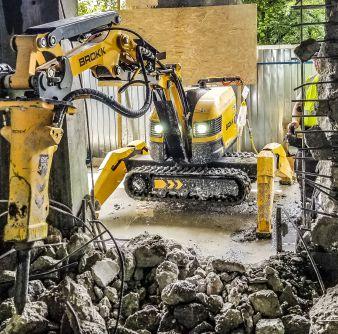
for fine detail work, allowing operators to remove a little concrete at a time, such as shaving down high points or blowouts from slurry walls.
The blunt tool’s flat face delivers a wider area of impact when breaking slab concrete, making it ideal for floors, steel beams encased in concrete, recycling and certain roadwork applications. What it lacks in precision, it makes up for in destructive power. Distributing energy across the entire face covers a significantly larger surface area than pointed tools and greatly increases overall efficiency.
This tool produces heavy vibrations, which limits its use in applications like indoor and top-down demolition and some road and bridge repair. However, the vibrations also make removing concrete from around steel beams easier since it encourages the concrete to “walk away” from the steel.
For maximum destructive power, the slab buster, or “elephant foot,” is the perfect tool for the job. The tool is shaped like a bell and distributes energy over a surface area three times its size, doubling production of both slab and on-grade demolition. However, vibrations and very little precision can limit applications.
When it comes to selecting the right tool for maximum efficiency, a little forethought can go a long way. Using the right bit speeds up production, allowing crews to move on to the next job that much sooner. A toolbox full of bits isn’t always necessary, but for operations looking to maximize their capabilities, having options on hand increases versatility and efficiency. CRS
8 milwaukeetool.com
Milwaukee Tool has announced the addition of its MX Fuel 14-inch cut-off saw that offers a batterypowered solution. Part of the new MX Fuel Equipment System, the new saw features a full 14-inch blade capacity, the fastest cuts from start to finish and no gas headaches, allowing users to work safer and be more productive. With a push-button activation, users can start the tool in seconds, getting up and running faster than ever before by eliminating the
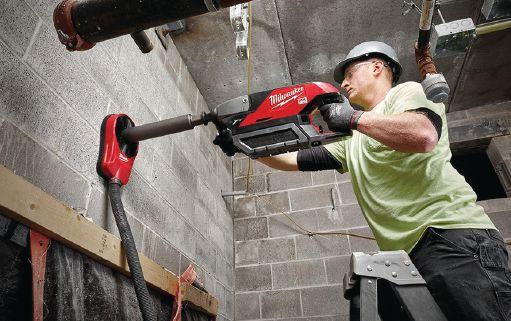
repetitive motions of pull starts. With the same cut speed as the leading twocycle gas saw and a full 14-inch blade capacity users can cut more in a single pass and there is no sacrifice of




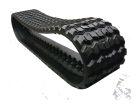


performance or capability. With up to 50 percent less noise and reduced vibration for a smoother cut, the battery-powered equipment also eliminates emission concerns and is safe to use

both indoors and outdoors. As an added benefit, One-Key provides the ability to track the saw with community tracking and alerts, complete inventory management and smart-equipment technology to secure the user’s investment. Milwaukee Tool’s MX Fuel Equipment System is a cordless system designed for the light equipment market that delivers the performance, run-time, and durability demanded by the trades without the hazards associated with emissions, noise, vibration and the frustrations of gas maintenance. Each of




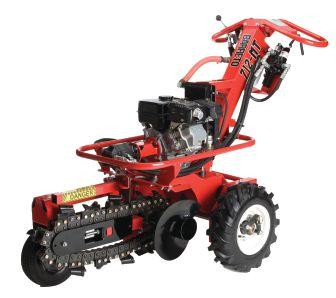

the solutions on the system go beyond the limitations of gasoline and power-cord units and operate off one completely compatible system all on the same battery. One-Key is a digital platform for tools and equipment. By integrating tool electronics with a custom-built cloud-based program, OneKey provides a new level of control and access to information. The ability to customize, track, and manage through One-Key changes the way users interact with their tools.
8 Hilti.com

Hilti North America has expanded its rotary and combination hammer tool portfolio with the next generation TE 70-ATC/AVR, a powerful SDS-Max combination hammer.
The new and improved tool is designed to help commercial contractors and tradespeople drill up to 40 percent faster in reinforced concrete and demolish more concrete than before. Understanding the importance of worker safety on a construction jobsite, the SDS-Max combination hammer includes Hilti’s exclusive Active Torque Control technology, which stops the tool body from spinning uncontrollably if the drill bit jams. The tool is also equipped with Hilti’s Active Vibration Reduction, a technology that makes it less tiring to use. The TE 70-ATC/AVR is strong enough to take on the most challenging applications, without sacrificing performance or ergonomics. With the fourth generation, Hilti customers will experience a premium performance – a hard-hitting, faster drilling tool that will help get the job done quickly. Users will unlock the full power of the SDS-Max combination hammer with the optimized durability and strength of Hilti’s TE-YX bits and new TE-YPX flat and pointed chisels designed specifically to withstand the power of this new tool. The wave design, polygon construction and self-sharpening technology of the TE-YPX (SDS Max) chisels offer high break resistance, virtually no sticking or jamming, and less stopping to sharpen or change broken chisels. The SDS-Max combination hammer also comes with a universal detachable power cord that fits eight other Hilti tools. The detachable power cord feature makes for quick cord changes and reduces repair downtime caused by cut or frayed cords. It also includes a brushless motor, which will increase the tool’s life, performance and requires less service work compared to other brushed tool models on the market.
The TE 70-ATC/AVR is backed by a tool warranty: 20 years of repair or replacement of defective parts; two years of no cost repair including wear and tear; and a guaranteed oneday in and out of repair centre.
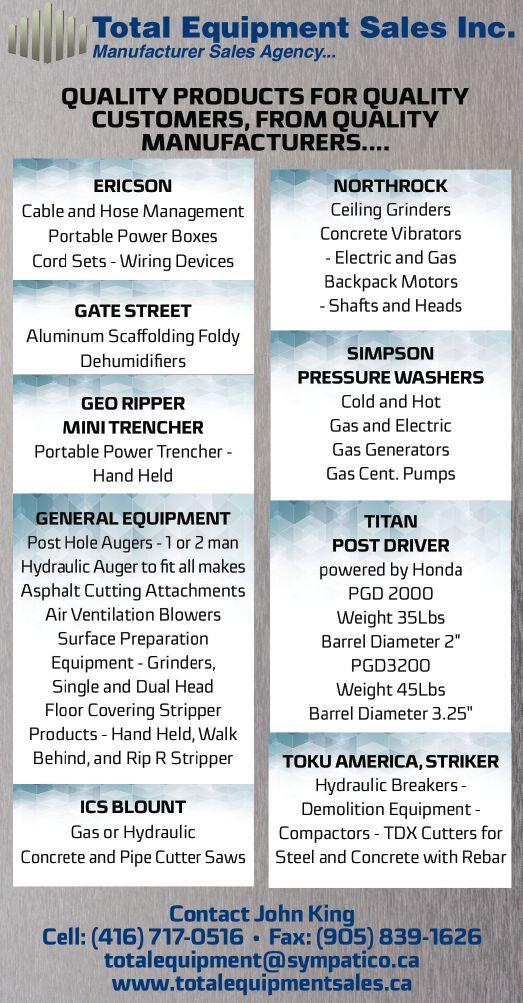
A HANDY GRINDER
8 generalequip.com
The new SG7 SurfacePro edge grinder from General Equipment Company is an ideal edge grinder for everyone


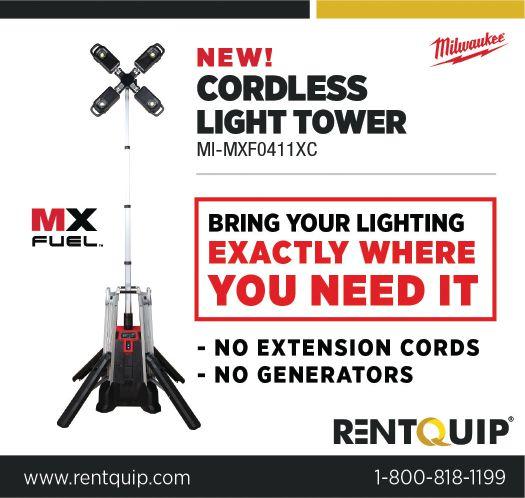
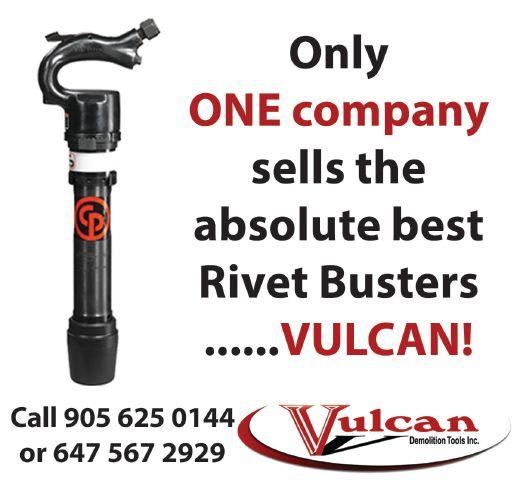

from do-it-yourselfers to commercial contractors. Intended for smaller areas, it can accommodate a wide variety of surface preparation applications, such as leveling concrete and asphalt, with excellent productivity and versatility. The heavygauge steel frame is ergonomically designed to allow the operator to work in a fully upright position. This greatly reduces the potential for lower back pain, strained knees or other occupational-related health issues, all while increasing productivity over hand-held grinders. The compact size of the SG7 provides an advantage to users. With a detachable handle and weighing only 27 pounds without a blade, it is easy to lift and transport, fitting in almost any size vehicle. It also provides the rigidity to remove materials with more accuracy and control than larger machines. Other standard features include Anti-Vibe caster wheels and a 1.5-inch diameter dust connection port and hose to handle applications with dust-control requirements. The SG7 also comes with a flexible dust shroud that incorporates a flip-up edge for improved viewing of the grinder cup edge when operating near features such as walls. The edge grinder comes supplied with a seven-inch diamond cup wheel.
AN ERGONOMIC SCREED
8 mbw.com
MBW’s ScreeDemon is an innovative and ergonomically friendly wet screed. MBW has announced the development of its very first electric version of the ScreeDemon powered by the M18 RedLithium battery system. Along with it being very easy to assemble, the equipment is one of the easiest to run wet screeds on the market. The screed is quieter than an engine version. The lights present on the product improve visibility in darker work areas. Zero emissions from the tool makes it perfect for indoor work as well. Assembly and disassembly are fast and easy due the screed’s clamp system. The sealed exciter requires no maintenance. Hand and arm vibration is designed to be 50 to 90 percent less.

AN ELECTRIC VERSION
8 husqvarna.com
The new Husqvarna Soff-Cut 150 E is – simply stated –

an electric version of the gas-powered Husqvarna Soff-Cut 150, which has become popular among contractors due to its reliable performance, low weight, swift handling and excellent results. The new electric version delivers additional benefits such as easier transportation, less noise, low maintenance and no exhaust fumes, which allows for indoor sawing.
“The new Soff-Cut 150 E was an immediate success at World of Concrete 2020.” says Bryan Jones, product manager for Soff-Cut at Husqvarna Construction Products North America.
“We believe it will be a good complement for those contractors and rentals that already appreciate the advantages of our Soff-Cut range,” he explains.
Due to its smooth electric motor, which vibrates less than a gas engine, the new machine produces cleaner and more even contracting joints. Just like the bigger Soff-Cut machines, the 150 E model is equipped with Husqvarna’s patented anti-ravel skid plate and Soff-Cut XL diamond blades. The blade block enclosure minimizes noise and is equipped with a vacuum port for easy dust control. Husqvarna Soff-Cut is a patented system for ultra-early-entry concrete sawing. This technology enables concrete to be cut within the first one or two hours after finishing and before final set. Husqvarna Soff-Cut provides solutions for minimizing the risk of random cracking, and simplifies the working process compared to conventional sawing.
8 minnich-mfg.com
Minnich Manufacturing, a manufacturer of concrete dowel pin drills, concrete vibrators and vibrator monitoring systems, introduced the new 50 cc gas-powered backpack concrete vibrator to the rental market at the ARA show. Driven by a powerful

Honda 50 cc motor with an ergonomically designed, fully adjustable harness, the lightweight 20.5pound backpack concrete vibrator offers operators outstanding mobility, reliable performance, superior comfort and reduced fatigue during concrete consolidation.
The 50 cc unit joins the 35 cc model in the Minnich back pack vibrator lineup. The Honda GX50 general-purpose engine expands the Minnich mini four-stroke vibrator lineup with a model that offers high output and light weight for excellent performance and fuel efficiency in more demanding commercial and rental applications. Featuring a compact and lightweight design, the GX50 is the first Honda four-stroke model in the two-horsepower class that is 360-degrees inclinable during operation and storage. Minnich’s 50 cc backpack concrete vibrator is equipped with many new features, including a removable throttle assembly which enables operators to relocate the throttle for easy and comfortable operation. All core, casings and vibrator heads are interchangeable between all Minnich gas-powered and electric flex shaft units with the true universal quick disconnect system, giving contractors equipment flexibility. Additional benefits include easy starting, low noise, simple maintenance, superb acceleration, and low fuel and oil consumption.
“Our powerful new 50 cc backpack gives operators the ability to move freely and easily with maximum comfort,” said Rob Minnich, president and chief marketing officer for Minnich Manufacturing. “It’s a productive and ergonomic solution that is ideal for rental, and we’re excited to share it with the industry.”
Minnich also displayed the Stinger electric flex shaft concrete vibrator, a 14.5-pound double-insulated universal motor that can drive the full line of Minnich vibrator shafts and heads from three-fourth inches to two-and-half inches. Available in a 15-amp (115-volt) version, it offers a more compatible speed range of 10,000 to 13,000 vibrations per minute to meet today’s concrete placement challenges.CRS
To advertise in this section, contact Danielle Labrie.

Phone: 888-599-2228 ext 245, Fax: 519-429-3094
Email: dlabrie@annexbusinessmedia.com
by Adam Snook

Recognize your limitations and hire the experts.
The rental industry makes you the ultimate Jack of all trades, master of none. For as long as people have been renting equipment, but before the huge multinational players came in, small rental company operators had to do it all. You were the counter man, mechanic, delivery driver, wash bay attendant and sometimes book-keeper.
The variety is a part of what initially attracted me to the rental industry. Never the same day twice. I enjoyed dealing with the customer at the counter one moment and then getting pulled to the shop to troubleshoot a piece of equipment the next minute. The days flew by.
It’s also what made it hard to expand, take time off, and be really focused on what the pressing issues are.
If you’re stuck in the shop working on equipment, and you are the one with the most equipment knowledge, there’s a good chance you’re missing out on upselling opportunities on the counter or the phone.
“If you can’t see what your strengths and weaknesses are, think about what you enjoy.”
production of that position. But I became keenly aware of my limitations as we continued to grow the businesses over the years.
I have solid outside sales abilities, but not a lot of patience required for the true relationship building required to secure a customer for years. Once we hired the right people to focus on that relationship building and gave them the tools to grow, our business grew exponentially.
Over the last five years it’s become very apparent that social media is a huge catalyst to business growth. I find myself quite funny, but according to my wife I might be the only one. We’ve seen huge growth in our business the last couple of years once I decided to bring on someone who has the right vision for our social media presence.
Self-awareness can be hard. If you can’t see what your strengths and weaknesses are, think about what you enjoy the most. That’ll point you in the right direction. If that doesn’t work, don’t be afraid to ask those you work with. A little criticism never hurts If they tell you that you’re not great on the counter or in the shop, it might be a good indicator on where you should focus.
Now the next part can sometimes be harder than realizing your weaknesses. You’re ideally looking to hire someone smarter than yourself to fill that need. Being the owner of the business for years and having always done it my way is often a hindrance to getting quality people in to fill those positions.
You need to get out of your own way.
Conversely, if you’re on the counter dealing with customers yet your strengths are more suited to repairing equipment, you’re probably missing out on revenue opportunities by not having someone with a salesman’s attitude up front.
Believe me, I’m aware how hard it is to admit our own faults or weaknesses. I’ve always been proud of my ability to step in to most any position, without noticing a huge difference in
Once you bring the right people in to balance your abilities and you’ve given them all they need to be successful, you’ll see the business starts to take care of itself. CRS
Adam Snook owns JustBins, a Regina-based provider of waste disposal solutions. His background includes building First Choice Rentals, an Alberta based equipment rental and oilfield service provider.
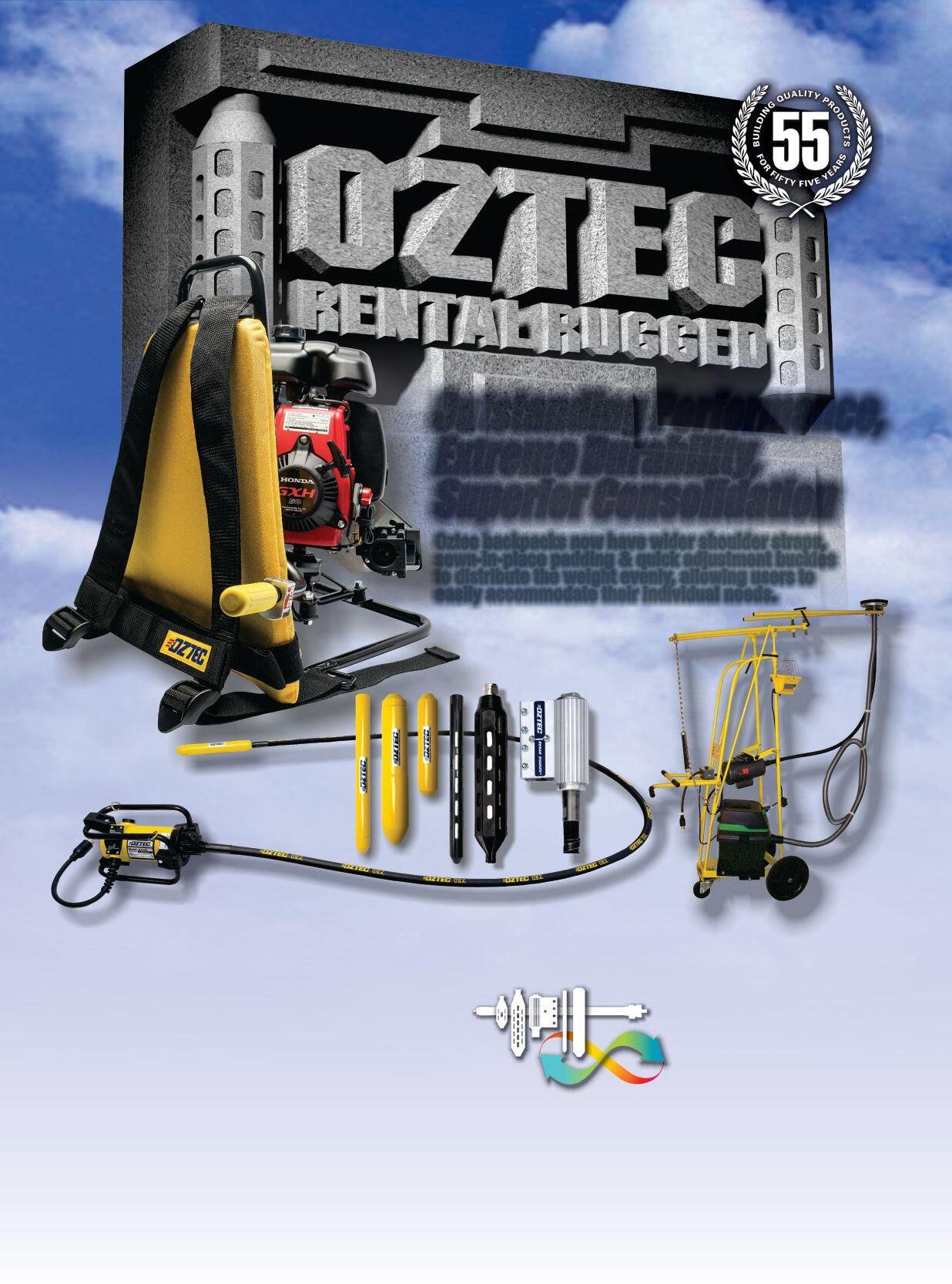








Vibra-pulse technology
The compact and powerful JM-1450 electric water jet gives your customers as much pressure as they can get from an electric jet. It generates 1500 psi at 1.7 gallons per minute, yet it only pulls 13 amps. Its powerful stream of high-pressure water cuts through grease, sand and ice in ways no snake can.
The JM-1450 features Vibra-pulse ® that helps the hose slide around tight bends in small lines for better cleaning power. This unique feature allows flow rate to remain the same whether the pulse is on or off.
Call the Drain Brains ® at 800-245-6200, or visit www.drainbrain.com/jetset